Unit 5 Poems Reading and Thinking 1 课件(29张,内嵌音频)人教版(2019)选择性必修 第三册
文档属性
| 名称 | Unit 5 Poems Reading and Thinking 1 课件(29张,内嵌音频)人教版(2019)选择性必修 第三册 |  | |
| 格式 | pptx | ||
| 文件大小 | 21.1MB | ||
| 资源类型 | 教案 | ||
| 版本资源 | 人教版(2019) | ||
| 科目 | 英语 | ||
| 更新时间 | 2025-03-05 09:35:40 | ||
图片预览

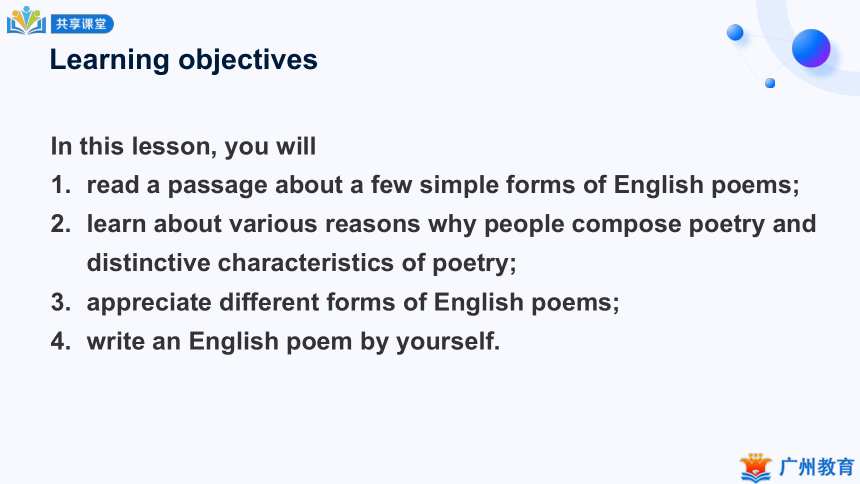
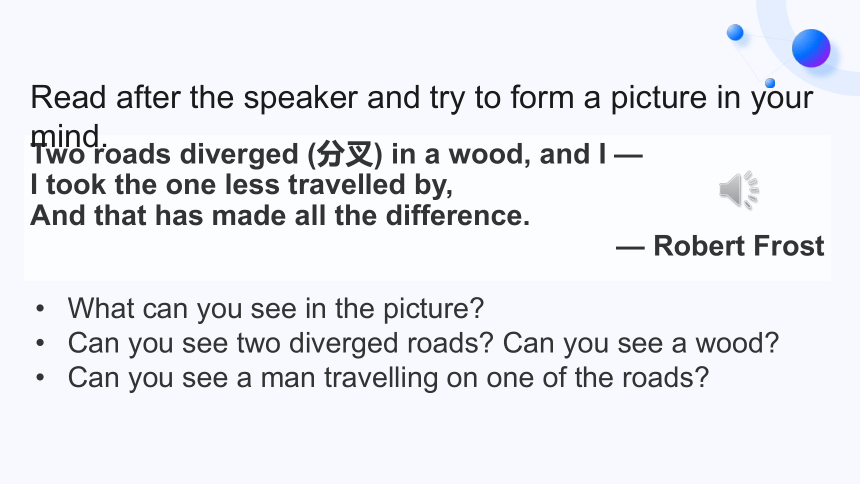
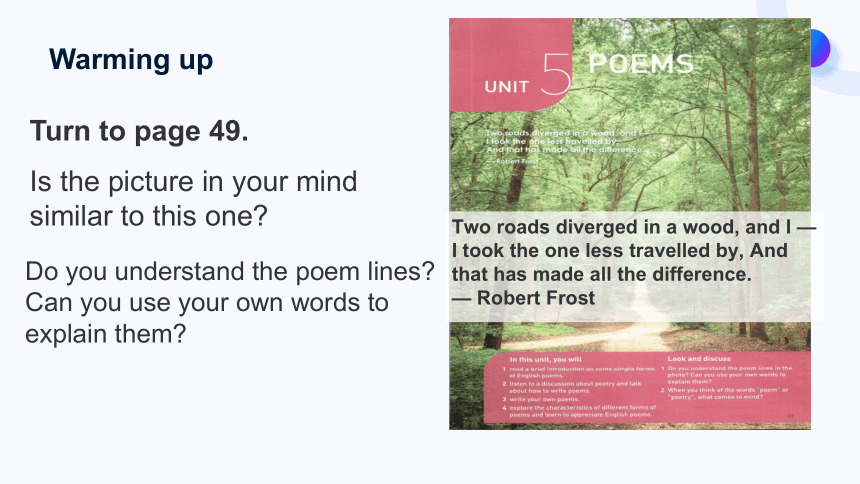

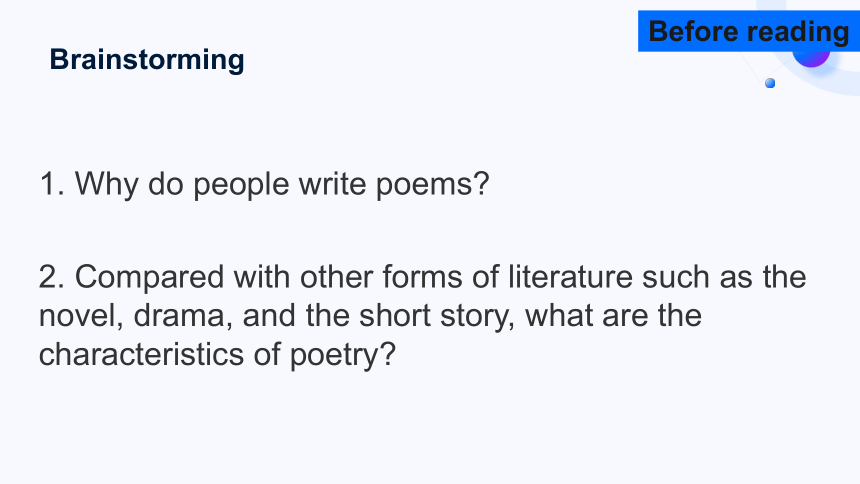
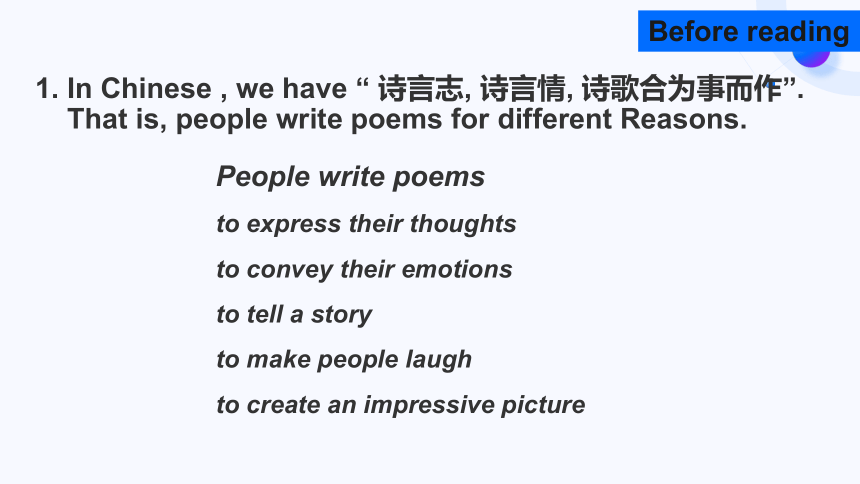
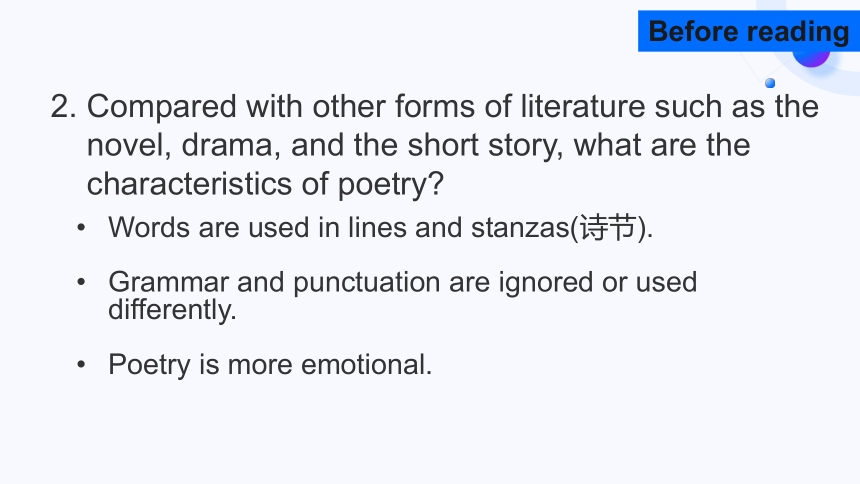
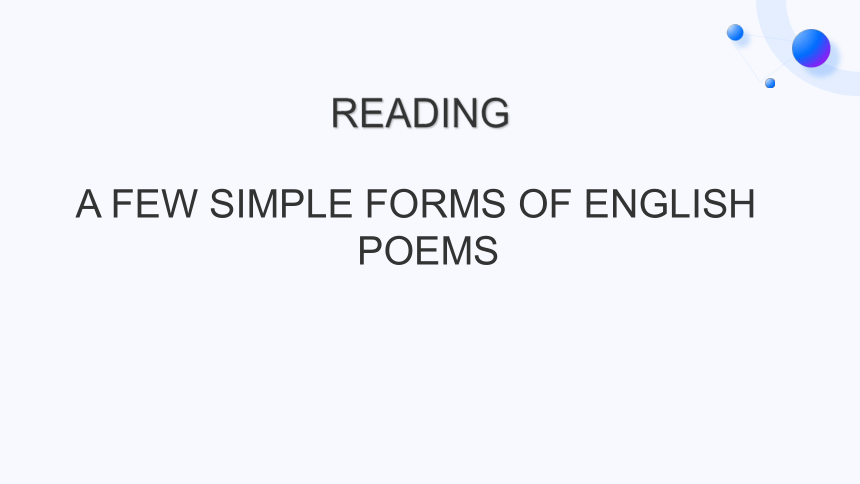
文档简介
(共29张PPT)
Lesson 1 Reading and Thinking (1)
POEMS
In this lesson, you will
read a passage about a few simple forms of English poems;
learn about various reasons why people compose poetry and distinctive characteristics of poetry;
appreciate different forms of English poems;
write an English poem by yourself.
Learning objectives
Two roads diverged (分叉) in a wood, and I —
I took the one less travelled by,
And that has made all the difference.
— Robert Frost
What can you see in the picture
Can you see two diverged roads Can you see a wood
Can you see a man travelling on one of the roads
Read after the speaker and try to form a picture in your mind.
Turn to page 49.
Is the picture in your mind similar to this one
Do you understand the poem lines
Can you use your own words to explain them
Two roads diverged in a wood, and I —
I took the one less travelled by, And that has made all the difference.
— Robert Frost
Warming up
Two roads diverged in a wood, and I —
I took the one less travelled by, And that has made all the difference.
— Robert Frost
Robert Frost (1874-1963) is an American poet. He uses the image of a split path to talk about choices in life.
Facing a choice in life, Frost says he took the “one less travelled”, which means he made a choice that most people don’t, and he felt that it was the right decision.
Warming up
Why do people write poems
2. Compared with other forms of literature such as the novel, drama, and the short story, what are the characteristics of poetry
Before reading
Brainstorming
1. In Chinese , we have “ 诗言志, 诗言情, 诗歌合为事而作”.
That is, people write poems for different Reasons.
People write poems
to express their thoughts
to convey their emotions
to tell a story
to make people laugh
to create an impressive picture
Before reading
Compared with other forms of literature such as the novel, drama, and the short story, what are the characteristics of poetry
Words are used in lines and stanzas(诗节).
Grammar and punctuation are ignored or used differently.
Poetry is more emotional.
Before reading
READING
A FEW SIMPLE FORMS OF ENGLISH POEMS
1. What is the main topic of the text
It is about a few simple _____ of _____________.
forms
English poems
Fast reading (3 min)
2. How many forms of poems are introduced What are they
Scan and skim the title, topic sentences and key words.
Fast reading (3 min)
Five kinds
Nursery rhymes
List poem
Haiku
Cinquain
Tang poems
Fast reading (3 min)
童谣 清单诗 五行诗 俳句诗 唐诗
Read Para. 1 and find out the two important points mentioned.
reasons why people compose poetry
distinctive characteristics of poetry
Detailed reading
tell a story
describe a certain image
convey certain feelings
Reasons why people compose poetry
Dinstinctive characteristics of poetry
economical use of words,
descriptive and vivid language,
integrated imagery,
literary devices, e.g. simile, metaphor
arrangement of words and lines, rhymes, and rhythm
Para 1. introduces the reasons why people compose poetry and distinctive characteristics of poetry.
Detailed reading
Read Para. 1 and find out the two important points mentioned.
Read Paragraph 2-6. Finish the table on page 51.
Detailed reading
Type of poem Characteristics Example Topics and poetic devices
Nursery rhyme A
concrete but creative language
love between father and baby
rhymes, repetition
Hush, little /baby, /don’t say /a word,
Papa’s /going to /buy you/ a mock/ingbird.
If that /mocking/bird won’t/ sing,
Papa’s going to buy you a diamond ring.
If that diamond ring turns to brass,
Papa’s going to buy you a looking glass.
If that looking-glass gets broke,
Papa’s going to buy you a billy-goat.
If that billy-goat won’t pull,
Papa’s gonna buy you a cart and bull.
[ :d]
[ ]
[a:s]
[ u]
[ l]
Nursery rhyme (童谣)
Type of poem Characteristics Example Topics and poetic devices
List poem B
C
list of things, people, ideas, or descriptions of a particular theme
flexible line length
repeated phrases for patterns and rhythm
nature
repetition
life
repetition
Type of poem Characteristics Example Topics and poetic devices
Cinquain D
simple form
five lines
brother
strong picture or mood
Detailed reading
Type of poem Characteristics Example Topics and poetic devices
Haiku E
17 syllables
three lines containing 5, 7, and 5 syllables
nature
Detailed reading
Type of poem Characteristics Example Topics and poetic devices
Tang poem F
structured
waiting
Detailed reading
Type of poem Characteristics Example Topics and poetic devices
Nursery rhyme concrete but creative language A love between father and baby
rhymes, repetition
List poem B
C
list of things, people, ideas, or descriptions of a particular theme
flexible line length
repeated phrases
for patterns and
rhythm
nature
repetition
life
repetition
Detailed reading
Read Paragraph 2-6. Finish the table on page 51.
Type of poem Characteristics Example Topics and poetic devices
Cinquain D
Haiku E
Tang poem F
simple form
five lines
brother
strong picture or mood
17 syllables
three lines containing 5, 7, and 5 syllables
nature
structured
waiting
Para 2-6 introduces different forms of English poems.
Detailed reading
Para. 7: The writer encourages readers to write their own poems.
Detailed reading
Review
Group work:
Discuss in groups and share your feelings.
Which poem do you like best Why
Does each of the poems we’ve read paint a picture in your mind Which poem does What’s the picture
Personally, I like the nursery thyme “Hush Little Baby” best. Because it rhymes, has a strong rhythm and is easy to learn and recite.
Nearly all the poems paint pictures in my mind. For example, from poem A, I can see a father gently holding his baby and singing the baby to sleep.
In this lesson, we have learned:
1. about a few simple forms of English poems;
2. to summarize characteristics of different English poems;
3. to understand topics and poetic devices of different forms of English poems;
4. to appreciate some forms of English poems.
Summary
Listen to the recording of the text and read aloud the poems.
Write an English poem by yourself.
Homework
Lesson 1 Reading and Thinking (1)
POEMS
In this lesson, you will
read a passage about a few simple forms of English poems;
learn about various reasons why people compose poetry and distinctive characteristics of poetry;
appreciate different forms of English poems;
write an English poem by yourself.
Learning objectives
Two roads diverged (分叉) in a wood, and I —
I took the one less travelled by,
And that has made all the difference.
— Robert Frost
What can you see in the picture
Can you see two diverged roads Can you see a wood
Can you see a man travelling on one of the roads
Read after the speaker and try to form a picture in your mind.
Turn to page 49.
Is the picture in your mind similar to this one
Do you understand the poem lines
Can you use your own words to explain them
Two roads diverged in a wood, and I —
I took the one less travelled by, And that has made all the difference.
— Robert Frost
Warming up
Two roads diverged in a wood, and I —
I took the one less travelled by, And that has made all the difference.
— Robert Frost
Robert Frost (1874-1963) is an American poet. He uses the image of a split path to talk about choices in life.
Facing a choice in life, Frost says he took the “one less travelled”, which means he made a choice that most people don’t, and he felt that it was the right decision.
Warming up
Why do people write poems
2. Compared with other forms of literature such as the novel, drama, and the short story, what are the characteristics of poetry
Before reading
Brainstorming
1. In Chinese , we have “ 诗言志, 诗言情, 诗歌合为事而作”.
That is, people write poems for different Reasons.
People write poems
to express their thoughts
to convey their emotions
to tell a story
to make people laugh
to create an impressive picture
Before reading
Compared with other forms of literature such as the novel, drama, and the short story, what are the characteristics of poetry
Words are used in lines and stanzas(诗节).
Grammar and punctuation are ignored or used differently.
Poetry is more emotional.
Before reading
READING
A FEW SIMPLE FORMS OF ENGLISH POEMS
1. What is the main topic of the text
It is about a few simple _____ of _____________.
forms
English poems
Fast reading (3 min)
2. How many forms of poems are introduced What are they
Scan and skim the title, topic sentences and key words.
Fast reading (3 min)
Five kinds
Nursery rhymes
List poem
Haiku
Cinquain
Tang poems
Fast reading (3 min)
童谣 清单诗 五行诗 俳句诗 唐诗
Read Para. 1 and find out the two important points mentioned.
reasons why people compose poetry
distinctive characteristics of poetry
Detailed reading
tell a story
describe a certain image
convey certain feelings
Reasons why people compose poetry
Dinstinctive characteristics of poetry
economical use of words,
descriptive and vivid language,
integrated imagery,
literary devices, e.g. simile, metaphor
arrangement of words and lines, rhymes, and rhythm
Para 1. introduces the reasons why people compose poetry and distinctive characteristics of poetry.
Detailed reading
Read Para. 1 and find out the two important points mentioned.
Read Paragraph 2-6. Finish the table on page 51.
Detailed reading
Type of poem Characteristics Example Topics and poetic devices
Nursery rhyme A
concrete but creative language
love between father and baby
rhymes, repetition
Hush, little /baby, /don’t say /a word,
Papa’s /going to /buy you/ a mock/ingbird.
If that /mocking/bird won’t/ sing,
Papa’s going to buy you a diamond ring.
If that diamond ring turns to brass,
Papa’s going to buy you a looking glass.
If that looking-glass gets broke,
Papa’s going to buy you a billy-goat.
If that billy-goat won’t pull,
Papa’s gonna buy you a cart and bull.
[ :d]
[ ]
[a:s]
[ u]
[ l]
Nursery rhyme (童谣)
Type of poem Characteristics Example Topics and poetic devices
List poem B
C
list of things, people, ideas, or descriptions of a particular theme
flexible line length
repeated phrases for patterns and rhythm
nature
repetition
life
repetition
Type of poem Characteristics Example Topics and poetic devices
Cinquain D
simple form
five lines
brother
strong picture or mood
Detailed reading
Type of poem Characteristics Example Topics and poetic devices
Haiku E
17 syllables
three lines containing 5, 7, and 5 syllables
nature
Detailed reading
Type of poem Characteristics Example Topics and poetic devices
Tang poem F
structured
waiting
Detailed reading
Type of poem Characteristics Example Topics and poetic devices
Nursery rhyme concrete but creative language A love between father and baby
rhymes, repetition
List poem B
C
list of things, people, ideas, or descriptions of a particular theme
flexible line length
repeated phrases
for patterns and
rhythm
nature
repetition
life
repetition
Detailed reading
Read Paragraph 2-6. Finish the table on page 51.
Type of poem Characteristics Example Topics and poetic devices
Cinquain D
Haiku E
Tang poem F
simple form
five lines
brother
strong picture or mood
17 syllables
three lines containing 5, 7, and 5 syllables
nature
structured
waiting
Para 2-6 introduces different forms of English poems.
Detailed reading
Para. 7: The writer encourages readers to write their own poems.
Detailed reading
Review
Group work:
Discuss in groups and share your feelings.
Which poem do you like best Why
Does each of the poems we’ve read paint a picture in your mind Which poem does What’s the picture
Personally, I like the nursery thyme “Hush Little Baby” best. Because it rhymes, has a strong rhythm and is easy to learn and recite.
Nearly all the poems paint pictures in my mind. For example, from poem A, I can see a father gently holding his baby and singing the baby to sleep.
In this lesson, we have learned:
1. about a few simple forms of English poems;
2. to summarize characteristics of different English poems;
3. to understand topics and poetic devices of different forms of English poems;
4. to appreciate some forms of English poems.
Summary
Listen to the recording of the text and read aloud the poems.
Write an English poem by yourself.
Homework
